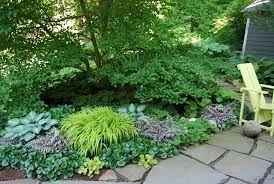
Having a shady spot to rest in your garden should be one of your goals as gardeners....a place to sit back and enjoy the fruits of your labors. If you have lived with your garden for a while, you will know your favorite places. Investigate these areas as possible sitting areas.
A woodland setting on a hot summer day offers a protective canopy of tall trees. These shady retreats may not always be as showy as sunny borders, but they offer interesting scenes, with a layering of understory trees or shrubs and a mix of herbaceous plants at your feet.
The best sitting areas have both sun and shade. But if you have to choose one or the other, generally a sunny location is better. There are ways to provide shade if the sun becomes too bright: an arbor, an umbrella or an awning, for example.
Note where the sun falls in your garden. The south side of the house is in the path of the sun for most of the day and is the warmest. The west side gets the afternoon sun and is the next warmest, followed by the east side which receives morning sun. The north side of the house is the coldest because it is shaded most of the day.
Small gardens, usually partially shaded by buildings, need cheerful places where sunlight streams through the foliage and pools on garden furniture, flowers and paths. Study how the light falls in your garden and devise as many opportunities as you can to make the garden sparkle. Variations of shade and sun throughout the day create different visual effects during day and evening hours.
The “show” changes as light moves and fades. Paving and ground covers provide a surface for catching the play of light in the garden. To bring light into an entrance garden shaded by trees, remove the lower branches and thin the canopies, allowing sunlight to dapple the garden below. Cream or white variegated leaves lighten up shady parts of a garden. Chartreuse or gold foliage also has a warming effect in shade. White or blue flowers can brighten up a shady area.
Dappled shade is prettier than dark shade and usually sufficient protection from heat and glare. Select trees with open branches and delicate leaves and trim any dense vines. If a patio is shaded by walls, try to create a view from the patio that is bathed in light, where you can watch sunlight playing across the garden.
Trees and shrubs that are adapted to dense shade are valuable in the garden. Plants including Fatsia japonica, the hollies and mahonias are notable for their foliage, while others such as camellias are grown for their spectacular color. When planning your shade garden, think about layers: ground covers, small shrubs, and larger bushes. Think about colors and textures and your space.
Sunset’s Western Garden Book offers many suggestions for shade plants. A favorite of mine is Ajuga reptans (carpet bugle), which spreads by runners. There are several varieties with varied leaf colorings but all send up blue flower spikes in spring and early summer. Daphne odora ‘marginata’ (winter daphne) will take partial shade, provides a heavenly scent and is an evergreen. Hostas provide elegant foliage and a huge range of color. Lamium maculatum is a vigorous ground cover reaching six inches in height, with heart-shaped gray-green leaves with silvery markings. Pittosporum tobria ‘variegata’ is a dense, rounded shrub five to ten feet tall, with creamy white, fragrant orange blossoms in early spring. Vinca minor (dwarf periwinkle) makes a spreading mat of shiny, dark green leaves with blue flowers. There are many varieties available.
Visit a local nursery and browse through the shade plants. Be sure to note the plant’s mature size, usually indicated on the plant tag.
Let your garden reflect your environmental concerns as well as your aesthetic sense. It should be in harmony with nature, a place where you can enjoy the sounds of birds, insects and animal life and appreciate the patterns of light that change throughout the day. A shady oasis that provides the possibility of peaceful enjoyment can be a restorative place for you.
Workshop: Napa County Master Gardeners will conduct a composting workshop in partnership with the City and County of Napa and NRWS/NCRWS. The workshop is Saturday, September 7, at 9 a.m. at the Yountville Community Center. Learn how to turn yard waste and kitchen scraps into wonderfully rich, free compost for your garden. Discover the basics of backyard composting, worm composting, and grasscycling. Register here: http://compost.naparecycles.org/index.html.
Garden Tour: Napa County Master Gardeners will host a self-guided garden tour, “Down the Garden Path,” on Sunday, September 22, from 10 a.m. to 4 p.m. Visit seven unique gardens in Napa, all maintained by Master Gardeners. Tickets: $25 advance/$30 day of event. For more information and to purchase tickets, visit http://ucanr.edu/ucmgnapa or call707-253-4147. Find us on Facebook under UC Master Gardeners of Napa County.
Master Gardeners are volunteers who help the University of California reach the gardening public with home gardening information. Napa County Master Gardeners ( http://ucanr.org/ucmgnapa/) are available to answer gardening questions in person or by phone, Monday, Wednesday and Friday, 9 a.m. to Noon, at the U. C. Cooperative Extension office, 1710 Soscol Avenue, Suite 4, Napa, 707-253-4143, or from outside City of Napa toll-free at 877-279-3065. Or e-mail your garden questions by following the guidelines on our web site. Click on Napa, then on Have Garden Questions?